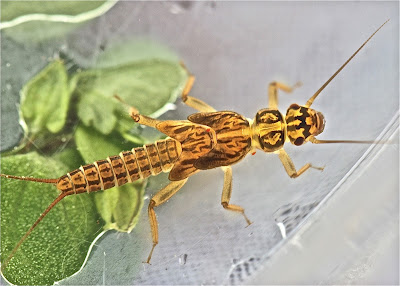That's the latest word from Steven Beaty. This is the most common Perlodid stonefly that we see in our streams at the moment, for which I've been using the name Isoperla namata. That has to change.
But there is more to the story. There is now a third species of Isoperla which produces a nymph with these very same features. The name for that species is currently being reviewed. So, for the moment, it's "Isoperla n.sp." (Isoperla new species). Isoperla montana and Isoperla n. sp. both occur in Virginia and North Carolina. The nymphs can be distinguished by slide mounting the mandibles and lacinia, but they can't be distinguished from observable physical features (at least, that's my understanding.)
So when we see these nymphs in our streams, we can't be sure if we're looking at Isoperla montana or Isoperla n. sp. That's where things stand at the moment. The next generation will be relying on DNA to make these decisions.
(For earlier discussions of the Isoperla namata/Isoperla montana problem, see the entries posted on 2/15/12 and 2/16/12.)
In 2011, Beaty, referring to this as I. nr. namata, described this species in the following way ("The Plecoptera of North Carolina," p. 24).
I. nr. namata -- nymphs ~ 11 mm; apex of lacinia narrower than base, constricted medially, with row of setae below subapical tooth approaching base; North Carolina specimens have a dark transverse band on head usually without backward extensions to lateral ocelli but sometimes with extensions and with lighter brown areas behind ecdysial line; abdominal longitudinal lines narrow; abdominal tergites with a transverse row of 6-8 faint dots.
The lacinia looks like this:






No comments:
Post a Comment